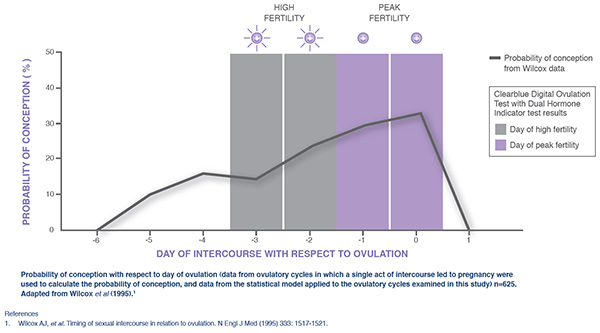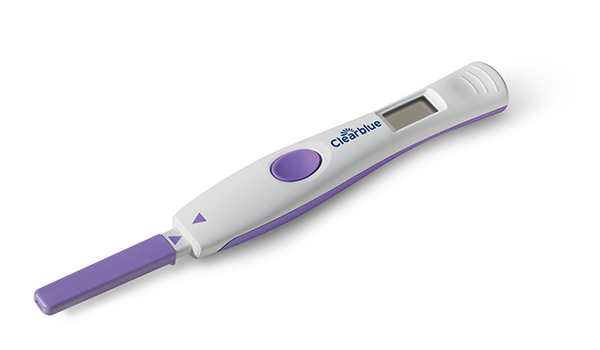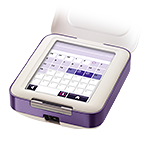Typically identifies 4 or more fertile days1
The Clearblue Advanced Digital Ovulation Test identifies the fertile window of the menstrual cycle by monitoring two key urinary fertility hormones, estrone-3-glucuronide (E3G; one of the urinary metabolites of estradiol) and luteinising hormone (LH). By measuring these two hormones, the Clearblue Advanced Digital Ovulation Test accurately detects the timing of a wider fertile period of typically 4 days, 2 more than other ovulation tests.
Conception is most likely to occur when intercourse takes place on the day before, or day of ovulation 2 and detection of the LH surge is a precise measure for the timing of ovulation.3However, conception is possible when intercourse takes place throughout the fertile window. Importantly it has been proposed that regular intercourse during the entire fertile period is more likely to lead to pregnancy, than intercourse at peak fertility alone.4 Establishing the timing of ovulation and a wider fertile window has practical utility to assist couples in appropriately timing intercourse.3
The Clearblue Advanced Digital Ovulation Test:
- Typically identifies 4 fertile days – 2 more than other ovulation tests – to maximise a woman’s chances of conception.1
- Accurately tracks the changing levels of 2 key urinary hormone metabolites - E3G and LH.
- Incorporates the latest fertility monitoring technology, which is more than 99% accurate at detecting the LH surge.5
- It's the only digital ovulation test brand with an unmistakable ☺ result.

Adaptive algorithm determines fertile days
Each menstrual cycle has a unique hormone profile. The test holder contains a sophisticated algorithm that adapts to a woman's individual hormone levels in order to accurately identify her fertile window.
Many women have small levels of LH present in their urine throughout their cycles – Clearblue Advanced Digital Ovulation Test sets a personalised threshold level for each woman, by measuring changes in hormone levels from their baseline (rather than measuring hormones to a constant uniform threshold, like some other ovulation tests).
The Clearblue Advanced Digital Ovulation Test utilises the following information to give a woman's daily fertility status:
- A sustained rise in E3G levels from baseline is used to define High Fertility days
- Trend analysis is applied to the E3G measurements to identify the first day of sustained rise, on which the device will display High Fertility
- Detection of the LH surge is used to determine days of Peak Fertility.

A quick and easy to interpret digital result
After 5 minutes, the test holder automatically reads and interprets the test result and delivers a digital indication of the user’s fertility status:
 |
Clear circle – Low Fertility It is unlikely, but not impossible, that intercourse at this time will result in pregnancy. The user should test again the following day. This result is displayed for 8 minutes.
|
 |
Flashing smiley – High Fertility If the user has intercourse today she will increase her chance of getting pregnant, but she must also test again the following day. The result will be displayed for 8 minutes.
|
 |
Smiley face – Peak Fertility This is the user’s most fertile time and the result will be displayed for 48 hours. If the user has intercourse whilst Peak Fertility is displayed she will maximise her chance of getting pregnant. The user should stop testing after the first day that Peak Fertility is displayed (an error symbol will be displayed simultaneously if she continues to test).
|
- 1 SPD Data on file. In a study of 87 women, 4 or more fertile days were identified in 80% of cycles using actual cycle length.
- 2 Wilcox A, Dunson D and Baird D. The timing of the "fertile window" in the menstrual cycle: day specific estimates from a prospective study. British Medical Journal. (2000) 321(7271): 1259-1262.
- 3 Lynch CD, Jackson LW, Buck Louis GM. Estimation of the day-specific probabilities of conception: current state of the knowledge and the relevance for epidemiological research. Paediatr Perinat Epidemiol (2006) Nov 20 (Suppl 1):3–12.
- 4 Barrett, J and Marshall, J. The risk of conception on different days of the menstrual cycle. Population Studies. (1969) Vol 23. (Pt 3): 455-462
- 5 SPD Data on file. Study found >99% agreement with AutoDELFIA reference method in 100 cycles (all cycle had LH surge >40mIU/ml).


